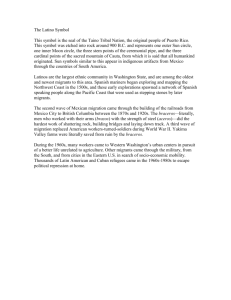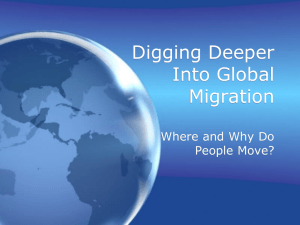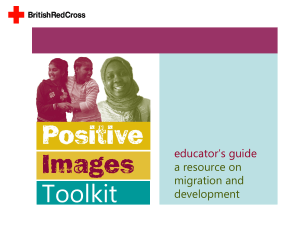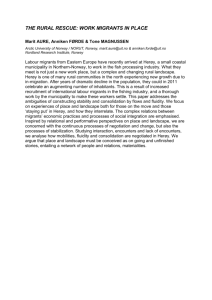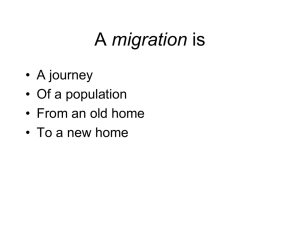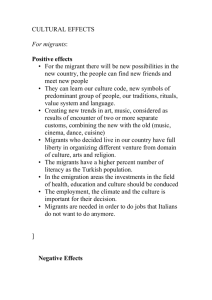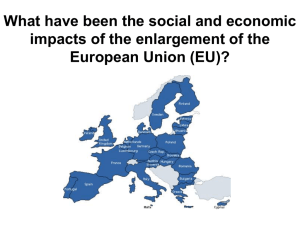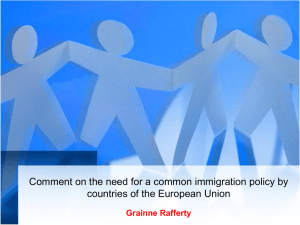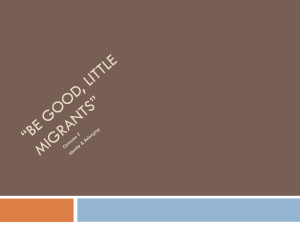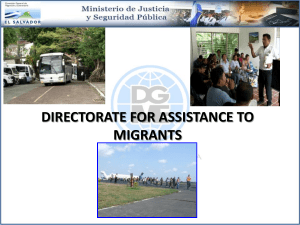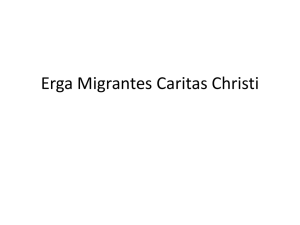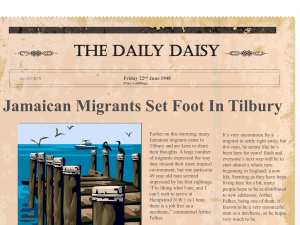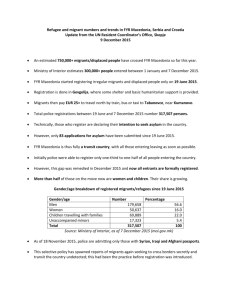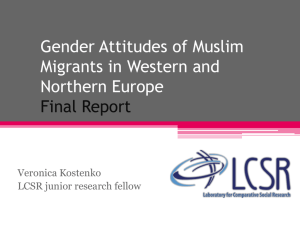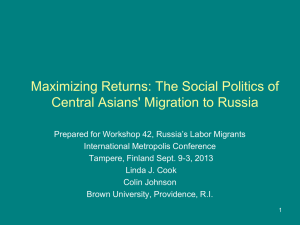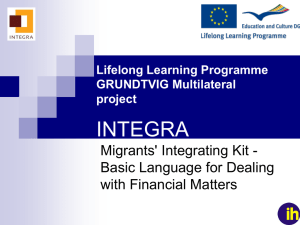Why education matters for children of non-EU migrants
advertisement
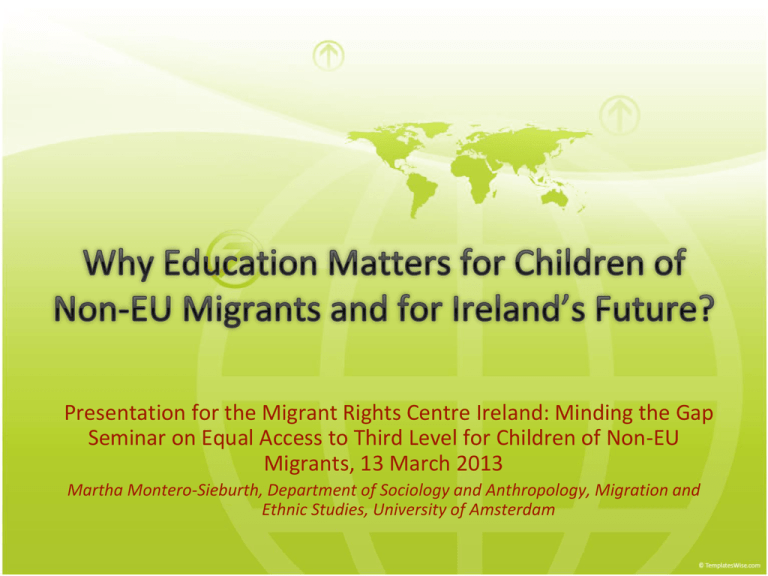
Presentation for the Migrant Rights Centre Ireland: Minding the Gap Seminar on Equal Access to Third Level for Children of Non-EU Migrants, 13 March 2013 Martha Montero-Sieburth, Department of Sociology and Anthropology, Migration and Ethnic Studies, University of Amsterdam United Nations database indicates : 49% of worldwide migrants are women 214 million transnationl migrants 740 million are internal migrants Globalization impacts economies, information sharing, knowledge acquisition, creates mass migration Knowledge spheres of education: complex skills are being demanded, competencies and sensibilities of global dimensions Children of migrants according to the SuarezOrozcos (2001) are the fastest growing segment of youth population in countries the world over. Cities instead of the nation state are now ever changing environments which leads to hyperdiversity (Orozco, Darbes, Dias and Sutin, 2011). As an anthropological educator, I study how migrants access education. I focus on what enables students to gain an education of value, and also what constrains them in the process. I focus on the opportunity structure that is available within national educational programs, schools and classrooms, and the types of obstacles that each presents. My work has taken me from: Mexico, Guatemala, Honduras, Costa Rica, (indigenous populations and women) , U.S.A. (diverse populations in Boston, and particularly Latinos) Spain (Latin American migrants) Netherlands with (1.5 and 2nd generation youth who are Dutch of Turkish and Moroccan backgrounds) Research in Latin America: Significance of social class differences in accessing schooling, social inequalities, and the education of women. Robert Levine’s work Research in the U. S.: language differences, differential treatment because of ethnicity, economic background and legal status influences educational attainment . Close to 38 million youth of the 310 million in population are of migrant origins. Luis Moll Funds of Knowledge within Communities Research in Spain: feminized migration, differential treatment even though language and culture are similar, different educational levels; issues of adaptation, circular migration and reunification of children Aparicio’s work in Madrid: Peruvians, Spaniards, and Moroccans Culturally patterned long distance family relationships (separation and reunification) and strident upward mobility by asylum seekers. Research in the Netherlands with 1.5 and 2nd generation: offseting the poor academic achievement of minorities through parental input, peer tutoring, and mentoring; polarization of Turkish and Moroccan students, refugees. Crul’s research Contextual issues as well as community support School to work transitions Early childhood education Educating women and providing access to both hard and soft science learning pays off Early childhood education provides learning readiness to students Curricular restructuring: modular learning offers opportunities for students to learn at own pace Apprenticeship programs allow students to progress within specialized fields Pipeline programs into specialties: medicine, law, business allow for experimentation Parental outreach and support; parental education is a strong predictor of children’s educational attainment Age at immigration: before 13 and after 13-19 Institutional structures affects learning opportunities: age of entry in school, contact hours, selection of programs and schools, age students are placed in academic versus career track, stigma of vocational programs, and availability of apprenticeship programs (Crul, 2008). Language proficiency in host language is one of the major determinants of access (bilingualism) Effects of life time earnings: U.S. figures:earnings from a single high school class would likely pour a total of $154 billion into the national economy. Unless high schools are able to graduate their students at higher rates, nearly 12 million students will likely drop out over the next decade, resulting in a loss to the nation of $1.5 trillion. (Alliance for Excellent Education Brief, 2011). College graduates pay 134% more in federal income taxes and 80% in federal, state, and local taxes than high school graduate (College Board, 2010). Source: U.S. Department of Education, 2011 The more differentiated the educational system, then the payoff for the effects of education on the labor market will be stronger Education effect is stronger when credentialization has taken place towards educational degrees Poverty among migrants in host countries is linked to factors such as language difficulties, lack of educational credentialing, job access and both social and educational networks. Suarez-Orozco points that « children of migrants have greater market income poverty rates than children in native born families. » Loss of human capital: Migrants experience positive selection, meaning higher levels of motivation than found in countries of origin, and this becomes greater when the difficulty of immigrating is greater (Baum and Flores, 2011). What happens when expectations are obstructed? Access issue: no access leaves many future students in limbo, unavailable to work or to academically progress, becoming a lost generation, (ninis generation) Integration leads towards citizenship, identity, advancement, and legalization The 1.5 generation, children of Ireland’s first generation Creation of hybrid identities, multiple identity theories Role progression to third level and integration leads to reducing future conflict and social cohesion Portes, Fernandez-Kelly and William Haller note that strong parental figures and cultural attachment to identity and traditions increase the success of youth who would otherwise have low success rates. Flows of migrants, while decreased at present given economic recession, what is the impact of those already in Ireland? Children of non-EU migrants Youth attempting to go into the third level Youth below the age of 16 who are in a limbo status Intergenerational mobility: What will it mean for the 1.5 and 2nd generation to not have a degree? Analysis of country specific context for focusing on school to work transitions Figuring out what the policy trade offs are, for legalizing students’ current situation, for citizenshp status, for reducing rates of schooling? Developing pro-active stances Using Suarez-Orozco’s argument: « educational system tied to the formation of the nation state citizens and consumers bonded to local systems to the neglect of larger global forces are likely to become obsolete, while those that proactively engage globalization’s new challenges are more likely to thrive. » (p.23).

